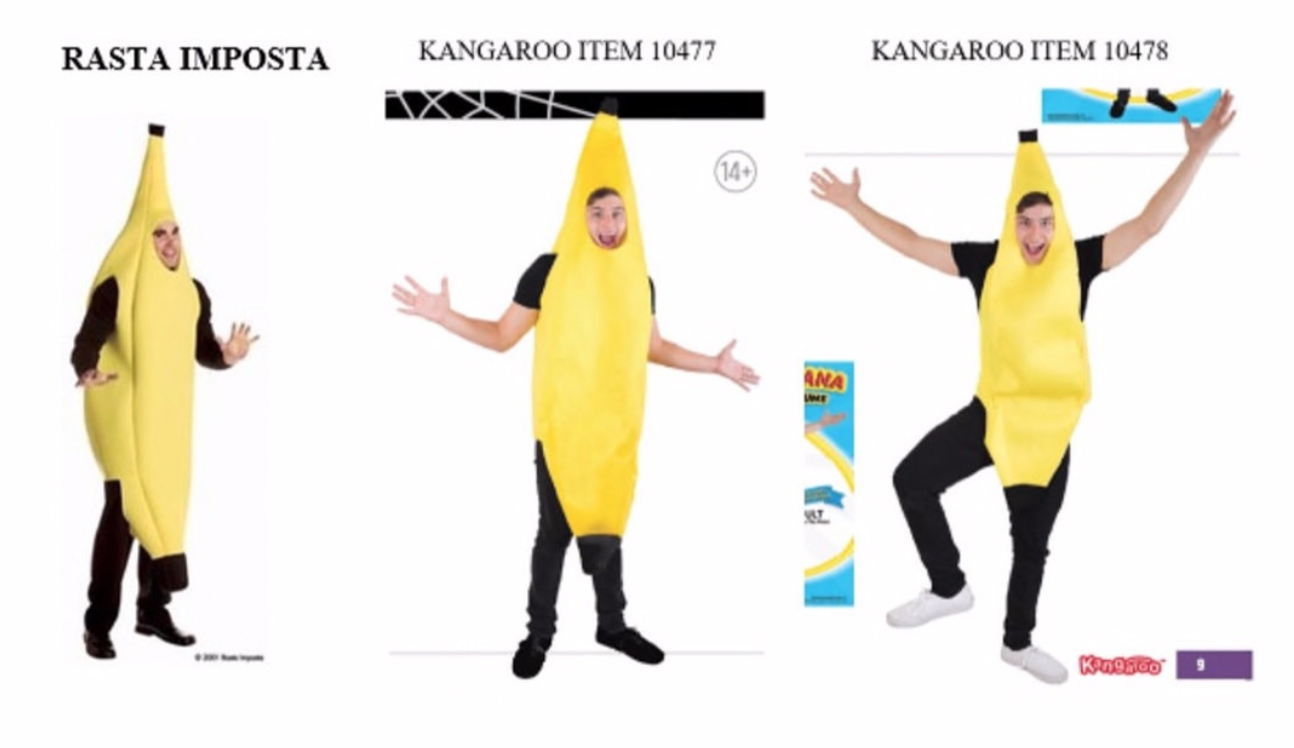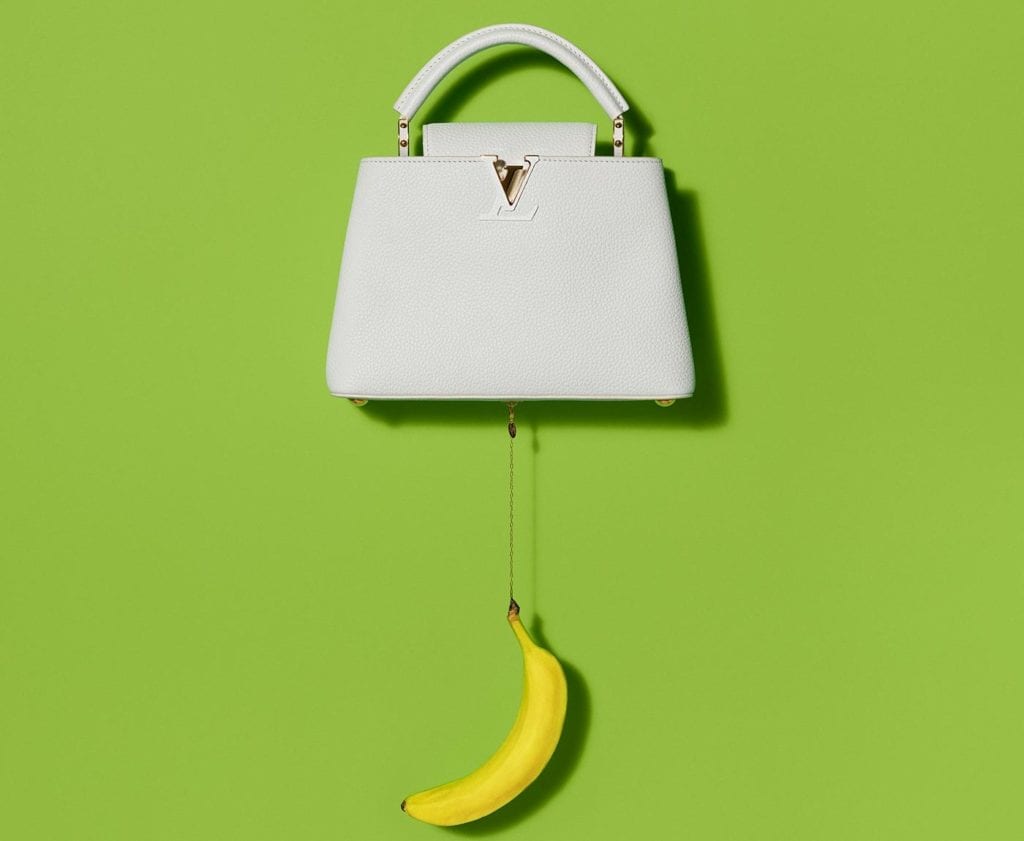What does a banana have to do with the fashion industry? Maybe more than meets the eye. A recent decision from the Third Circuit Court of Appeals in the copyright fight between costume-makers Kangaroo Manufacturing and Rasta Imposta – which centers on their full-body banana costumes – is one of the latest applications of the Supreme Court’s decision in Star Athletica v. Varsity Brands, a case that has been touted as having significant implications for fashion.
The case over two companies’ lookalike banana costumes came about when Halloween costume wholesaler Rasta Imposta, which maintains a copyright registration for a banana costume, filed suit against Kangaroo Manufacturing, alleging that it was manufacturing and selling a substantially similar costume, thereby giving rise to claims of copyright infringement, trade dress infringement, and unfair competition.
While the lower court tossed out the trade dress infringement claim, it sided with Rasta in a couple of respects, namely, requiring that Kangaroo Manufacturing immediately refrain from selling the allegedly infringing costume. Kangaroo appealed the preliminary injunction decision, arguing that the injunction should not have been issued because Rasta lacks a valid copyright since the appearance of its banana is not different than the appearance of any other banana.
The case ended up before the Third Circuit Court of Appeals in Philadelphia, whose 3-judge panel noted that while copyright law extends to “original works of authorship fixed in any tangible medium of expression,” there is a “special rule” when the work at issue is a useful one, i.e., one that has “an intrinsic utilitarian function that is not merely to portray the appearance of the article or to convey information.”
The design of a useful article is noteworthy because such a design is not eligible for copyright protection, unless, the 2- or 3-dimensional creative elements at play “can identified and imagined apart from the useful article [as a whole],” and when the creative elements are imagined separately, they must be capable of qualifying for copyright protection on their own. That is essentially the test that the Supreme Court set out in the Star Athletica case.
As the Third Circuit notes, the Supreme Court determined in Star Athletica that a “cheerleading uniform’s utilitarian ‘shape, cut, and dimensions’ are not copyrightable.” However, “the 2-dimensional design patterns” that appear on cheerleader uniforms may be eligible for copyright protection.
 Rasta Imposta’s costume (left) & Kangaroo’s costumes (right)
Rasta Imposta’s costume (left) & Kangaroo’s costumes (right)
So, what does that have to do with a banana costume? Well, as the Third Circuit stated that much like a garment or accessory, Rasta’s banana costume is a “useful article,” which means it must pass the Star Athletica separability test in order to enjoy protection.
In considering the protectability of the banana costume, the court held that “the artistic features [of the costume] … prove both separable and capable of existing independently [from the garment itself] as a copyrightable work.” That separate work, according to the court? A banana sculpture, with the non-useful features consisting of “the banana’s combination of colors, lines, shape, and length.” Once separated from the costume, the sculpture, the court notes, “is not intrinsically utilitarian and does not merely replicate the costume, [and] so, it may be copyrighted.”
On the other hand, “The cutout holes for the wearer’s arms, legs, and face; the holes’ dimensions; or the holes’ locations on the costume” – like the “shape, cut, and dimensions” of the cheerleader uniforms in Star Athletica – are not protectable “because those features are utilitarian.”
With that in mind, the Third Circuit’s panel upheld the injunction on the basis that “Rasta is reasonably likely to prove ownership of a valid copyright.”
In terms of how neatly such an analysis would translate to fashion cases, it would almost certainly be a bit less clear cut, as in Star Athletica , the Supreme Court did not liken the whole of a garment, itself, to a sculpture, and instead, separated out the uniforms’ individual stripes and chevrons as the potentially protectable elements. The court held that unlike the banana, which can exist almost in its entirely as a sculpture, only the uniforms’ stripes and chevrons can exist independently and if “applied in another medium” could be considered 2-dimensional works of art. As such, the scope of protection for garments is notably limited compared to the already rather limited protection held by the banana costume.
Nonetheless, when considered against a recent determination from the U.S. Copyright Office, which registered the design of adidas’ Yeezy Boost 350 in May – namely “irregular black lines of various lengths and shapes on a gray fabric with a black semi-circle in the arch and an orange dotted stripe on an off-white heel loop” for one version and “several grey lines in a wave pattern with a thick orange stripe on the outsole that fades toward the heel of the sneaker,” and a secondary “inner orange layer that adds intermittent orange coloring” for another – not all is lost for creatives seeking protection over their inherently useful garments, handbags, footwear, etc.
As for the banana case, itself, Joshua M. Dalton, who co-leads Morgan Lewis & Bockius LLP’s trademark and copyright litigation practice, told Bloomberg Law that it is “an example of how Star Athletica brought more clarity to determining copyrightability of the aesthetic aspects of useful articles.”
*The case is Silvertop Associates Inc., d/b/a Rasta Imposta v. Kangaroo Manufacturing Inc., 1-17-cv-07919 (3rd Cir.).











